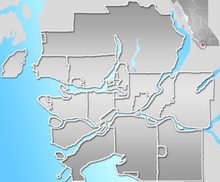Coal Harbour

From Wikipedia, the free encyclopedia
Coal Harbour is the name for a section of Burrard Inlet lying between Vancouver, Canada's downtown peninsula and the Brockton Peninsula of Stanley Park. It has also now become the name of the neighbourhood adjacent to its southern shoreline, which was redeveloped as an upscale high-rise condominium district in the 1990s.
The harbour is bounded by the Financial District to the south and Stanley Park to the north. To the east is Deadman's Island, the site of the naval station and museum HMCS Discovery, where the harbour opens up to the Burrard Inlet. The discovery of coal in the harbour in 1862 inspired the name. Within the harbour is a floating gas station for marine vessels.
Coal Harbour is home to Vancouver Harbour Water Aerodrome, located a few blocks from Canada Place.
History
Notable inhabitants and developments in Coal Harbour's past include:
- Sḵwxwú7mesh settlements, notably on Deadman Island, Brockton Point and Lumberman's Arch.
- In 1862 minor exploration began of the visible coal seams on the flank of the bluff overlooking the harbour, first noted by Captain Vancouver. This bluff was approximately where most of West Hastings Street is today. The coal was low-grade, but its occurrence in clays similar to porcelain-making clays of the English Midlands led to the staking of what is known as the Brickmaker's Claim by the Three Greenhorns. The Brickmaker's Claim is now the West End. No clay was ever mined nor porcelain ever made, but one of the Greenhorns was the developer of the clay mine and brickworks at Clayburn on Sumas Mountain near Abbotsford.
- A settlement of Kanakas (Hawaiians) near today's Bayshore Inn and the eastern end of Lost Lagoon was known as the Kanaka Rancherie, or the Cherry Orchard due to its many cherry trees. The area is now called Devonian Harbourside Park, and memorial cherry trees have been planted there in memory of AIDS victims.
- the Vancouver Boating Club, now Vancouver Rowing Club, from 1887 (originally at the bottom of the bluff at the foot of Howe Street)
- the Pacific Lumber Mill Company in the late 1800s
- The Royal Vancouver Yacht Club (their first clubhouse floated in Coal Harbour at the foot of Cardero street in 1903)
- Boeing Canada's Seaplane and Boat Factory beginning in the l 1919; (they purchased the Hoffar-Beeching Shipyard at 1927 West Georgia in 1929)
- William Boeing's yacht, the superb Taconite, was built at Hoffars in 1931.
- the Vancouver Shipyards through the 1930s
- the CP Rail Station & CP Steamships passenger terminal/dock
- Harbour Ferries, a tour-boat and water-taxi service, continues to operate from docks in Coal Harbour
- Howard Hughes, who resided in the top two floors of the Bayshore Inn (Westin Bayshore) for 5 months and 28 days in the 1970s (6 months would have triggered Canadian residency and taxation issues for Mr. Hughes).
- Trader Vic's, for many years held to be Vancouver's best night-out, was launched in a tiki-style hut next to the Bayshore.
- HMCS Discovery, a naval base on Deadman Island.
- In 1993 Vancouver City Council froze applications for development of the Marathon Realty lands between Canada Place and the Bayshore Hotel. The company was required to reach an agreement with The First Narrows Floating Co-op, representing floating home and live-aboard boat residents in pre existing marinas, for their inclusion in the redevelopment of the waterfront. Negotiations concluded with the guarantee of space for residents in Coal Harbour Marina on extended leases.[1]
Neighbourhood
The name Coal Harbour is also used to designate a relatively new official neighbourhood of the City of Vancouver. The neighbourhood is bounded to the southeast by Burrard Street, to the southwest by West Georgia and Pender Streets, and to the northwest by Stanley Park. The northwestern section features parkland, private marinas, several rowing and boating clubs and a community centre designed by architect Gregory Henriquez. Towards the Financial District in the southeast, and across Georgia Street, the neighbourhood is dominated by high-rise office and apartment buildings. Much of the area between Hastings Street and Georgia Street is part of the city's business district and in the days when it was an upper-class residential district West Pender Street was known as Blueblood Alley because of the many large mansions along it. The six floating homes in Coal Harbour, along with the twelve in False Creek are the only legal floating homes in the city of Vancouver.[citation needed]
Please contact Shaun directly shaun@shaunkimmins.com to discuss whether it's a good time for you to buy or sell and please feel free to comment on this or any of my other Blogs or visit me at my Century 21 In Town Realty website.



